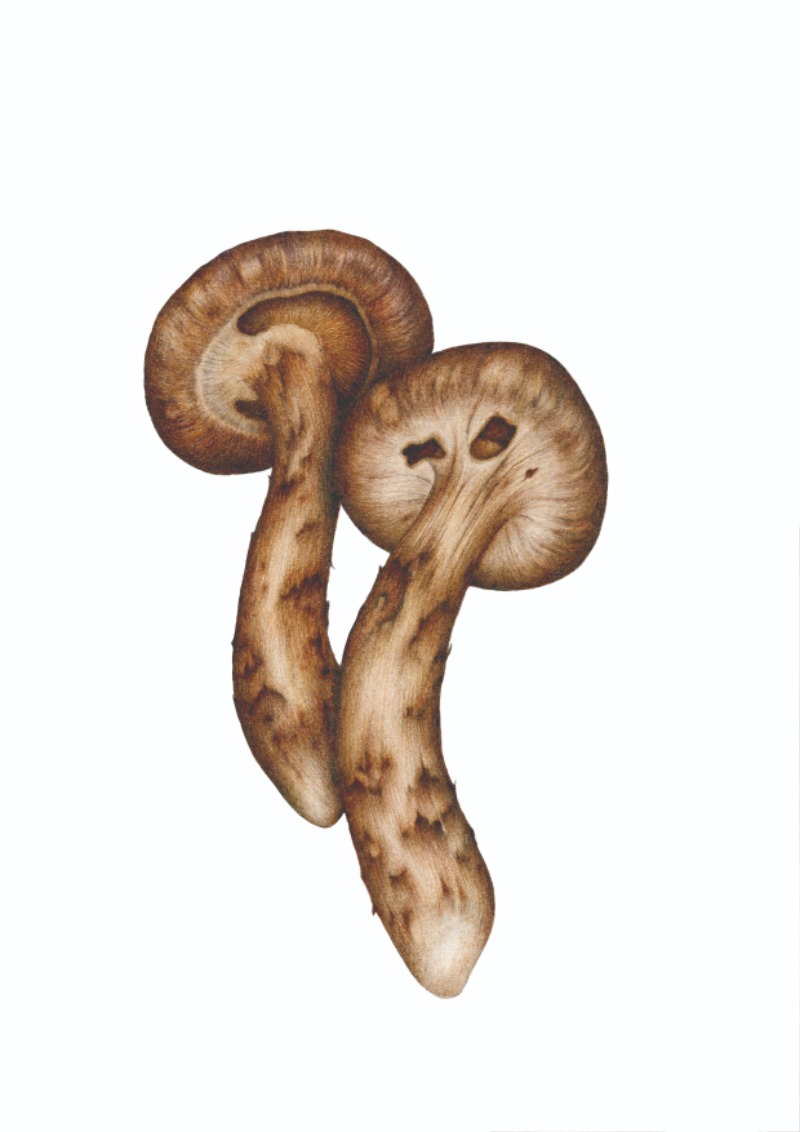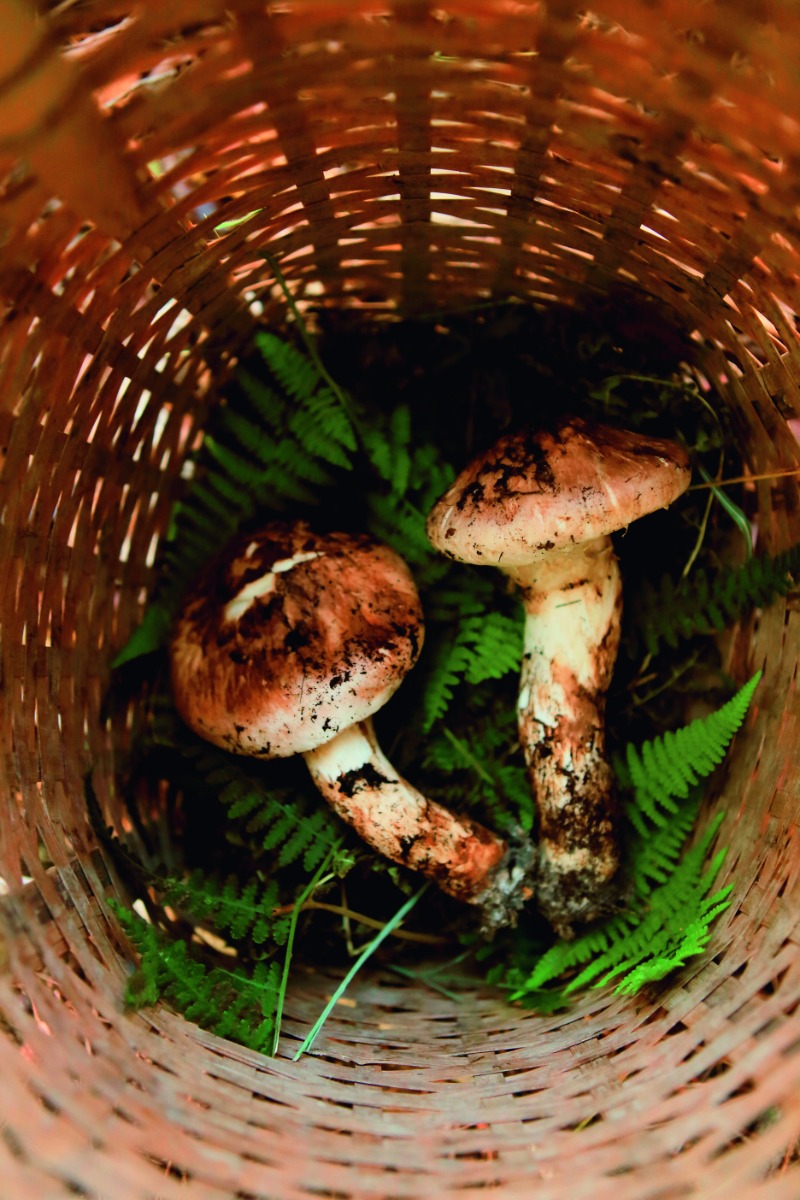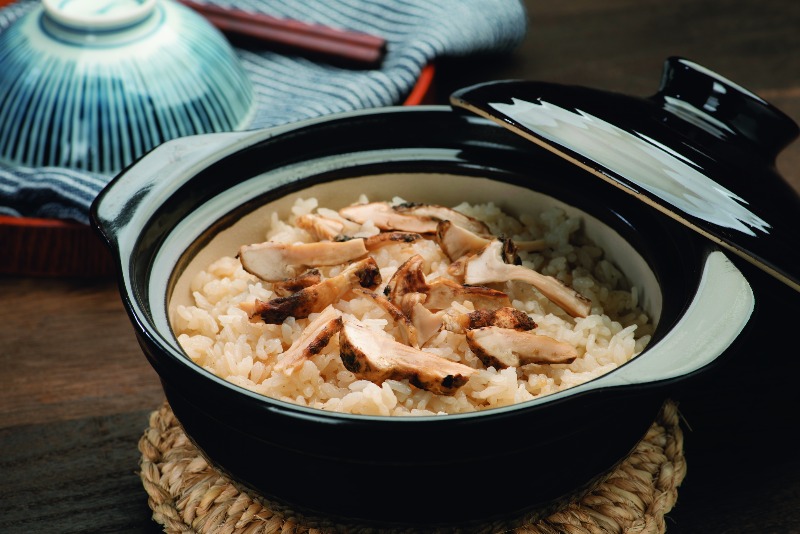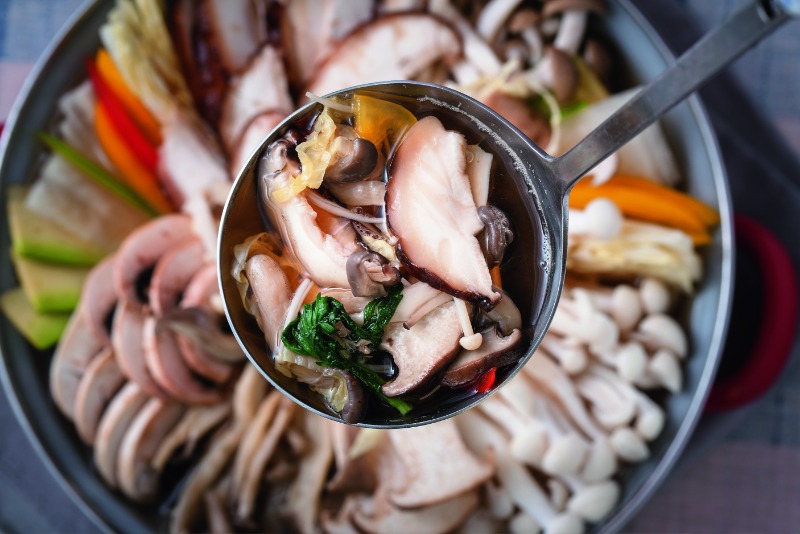There are countless mushrooms growing on Earth, including more than 2,000 edible kinds. When Koreans think of mushrooms, the first thing that comes to their mind is autumn, because it’s the harvest season for the particularly delicious pine mushrooms, so-named because they grow attached to pine trees.

Pine mushrooms that sprout under the shade of pine trees are a delicious gift of the fall season. They are very expensive because they cannot be cultivated, are sensitive to climate, and are difficult to collect.
Yi Gyu-bo, a writer from the mid-Goryeo period, described pine mushrooms (songi beoseot) in detail in his poem “Eating Pine Mushrooms.” (“Collected Works of Yi Gyu-bo [Dongguk isang gukjip], Vol. 14)
Mushrooms grow in rotten soil
Or maybe from a tree.
Because all are born of decay,
They are often feared to be poisonous.
This mushroom comes from the pine tree,
And is always covered with pine needles.
How abundant the pure scent
Growing from the vitality of the pine.
The first time I found them, following the scent,
Even a couple made a handful.
They say one who eats pine oil
Is the fastest to become an immortal.
So why is it not medicine?
IMPORTANCE IN THE ECOSYSTEM
Most people think that mushrooms are plants but they are not. Having no chlorophyll, they cannot photosynthesize and must obtain nutrients from other plants or animals, which is why they are said to resemble animals.
Button mushrooms and shiitake attach themselves to dead trees and decomposing organic matter. They also survive on nutrients left in animal waste. As Yi Gyu-bo wrote in his poem, not all mushrooms grown on rot cause poisoning. In fact, humans eat plenty of foods that are grown on rotting plants, since they allow for artificial cultivation. In China, as early as the 13th century, shiitake were grown on oak blocks. Button mushrooms began to be cultivated in France in the 17th century, using compost from melons and manure from horse droppings.
Mushrooms play a crucial role in ecosystems’ circulation of nutrients. The cell wall of trees is made up of cellulose, hemicellulose and lignin. Lignin is particularly difficult to decompose, and mushrooms are almost the only organisms that can do the job. Fungi decompose and eat dead trees, and the trees thus return to the soil and grow again from it.
Like porcini, truffles, and oyster mushrooms, pine mushrooms have a symbiotic relationship with living trees. They collect minerals from the soil, some of which they pass on to the roots of trees.
In return, the roots donate sugar to them. Probably because of this symbiotic relationship, pine mushrooms contain more minerals than other species.
DEMANDING GROWTH ENVIRONMENT
Most mushrooms are invisible to the human eye, and spread in the ground as a net-like mass of fungi called mycelium. The mycelium collects enough nutrients and absorbs water to form denser mycelial tissues called the fruiting body. What we eat is not the mycelium in the ground, but the fruiting body that corresponds to the flower of a plant.
Pine mushrooms are difficult to cultivate because they grow only on living trees, in symbiosis with the small roots, about 10 cm underground. They can be harvested during the summer and rainy season, when the ground temperature decreases, but the best time is autumn. When the underground temperature drops below 19 degrees Celsius, pine mushrooms’ mycelia spread wide, and their fruiting bodies appear aboveground. Rain is essential for growth, but too much is undesirable. The temperature should neither be too low nor too high, the pine trees neither too old nor too young, and, although the mushrooms are always covered with pine needles, they do not grow well if the cover is too thick.
THE FAME OF PINE MUSHROOMS

The best pine mushrooms have a modest cap and generous silvery white tip. Fresh pine mushrooms have a unique, elegant and distinguished pine scent that cannot be compared with that of other mushrooms.
© gettyimagesKOREA
Pine mushrooms grow only when all these conditions are met, which means they don’t come cheap. When their caps are not spread out and their stalks are more than 8 cm long, the price is particularly high. If their stems are not of uniform thickness or the caps have spread even a little, they are categorized as second-class, and if their caps are spread out like umbrellas, the price drops even further. Whatever the shape, there is no difference in taste or smell, but people tend to value things that are rare.
Moreover, the price fluctuates greatly with production volume. The main growing areas in Korea are Gangwon and North Gyeongsang provinces, with pine mushrooms grown in Yangyang, Gangwon Province, being the most famous. According to an article in the JoongAng Ilbo from September 18, 2021, first-grade Yangyang pine mushrooms fetched a record high price of 1.32 million won per kilogram in 2019.
Pine mushrooms are called songi beoseot in Korean, “songi” meaning “pine” and “boseot” meaning “mushroom.” Their popularity also affects the names of other mushrooms. King oyster mushrooms (sae songi), oyster mushrooms (cham songi), flowering mushrooms (ggot songi), willow oyster mushrooms (beodeul songi), and button mushrooms (yang songi) have “songi” in their names, though they are all different species.
SAVORED FOR THE SCENT
Although they contain nutrients such as protein, dietary fiber, vitamins and minerals, pine mushrooms are mainly sought-after due to their autumnal scent. Gourmands are particularly keen on them around Chuseok, the traditional autumn harvest festival. Rice cooked with pine mushrooms seems to fill you with the pure scent of pine trees, every time you take a bite. It is no wonder that eight hundred years ago, Yi Gyu-bo wrote that he felt he was becoming an immortal when he ate them.
The demand for autumn pine mushrooms never wanes, but unfortunately, harvests are on the decline. Annual production reached 1,300 tons until 1985, but has recently fallen to an average of merely 219 tons. There are four main reasons for this decline: the reduction of pine forests, climate change, the accumulation of fallen leaves and the effects of pine wilt disease. A 2009 study by the University of Oregon suggests that using the shallow-raking method when remixing the soil after harvesting does not affect yields the following year. Not remixing the soil at all, however, or raking too deeply, could reduce yields by up to a whopping 90 percent. This holds the message that people should learn to coexist with nature in a balanced way and treat it with respect.

Pot rice made with fresh cooked rice and pine mushrooms is the perfect autumn meal. The secret is to place the mushrooms on the rice just before steaming
© gettyimagesKOREA

Pine mushrooms are a wonderful addition to soups based on mussels, bonito flakes or kelp, and can also be enjoyed in a stew.
© TongRo Images
WILD MUSHROOMS REVISITED
Mushrooms are rich in umami, so even a cook with no special skills can use them in stews or stir-fries and be confident in achieving a deep, rich flavor. Pine mushrooms can be grilled with meat, covered in egg batter and pan-fried to make jeon or skewered to make sanjeok.
There are about four hundred types of edible mushrooms in Korea. Recently, the value of various native wild mushrooms is being re-examined. Morels and chanterelles, so prized in France, can also be tasted in Korea. According to an article in the Chosun Ilbo, published on October 18, 2018, the Korean name for morels is gombo boseot; they grow in spring in Sinan, South Jeolla Province. Chanterelles can be found in local traditional markets under various names, such as nightingale or cucumber flower mushrooms, and aeggot or oeggot boseot.
Few people know about these mushrooms, however, and in most cases, they are just added to stews. Hopefully, more people will learn to distinguish between the different kinds of mushrooms and enjoy their unique tastes and scents. This would, in turn, lead to greater interest in wild mushrooms in Korea and new and exciting recipes for them.